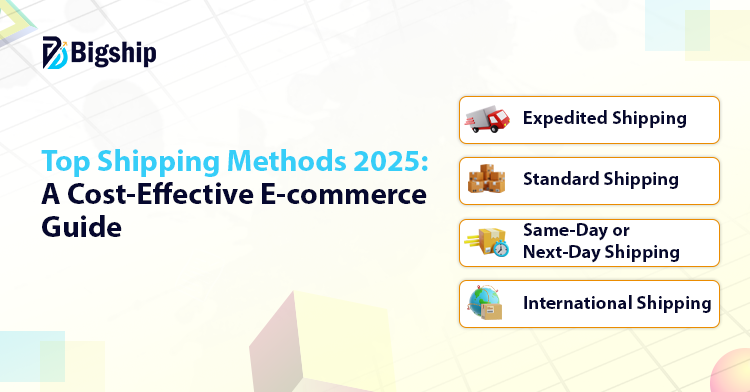Shipping connects businesses with commercial activity in the marketplace. The global logistics market, valued at USD 3,794.4 billion in 2023, is expected to grow steadily at a CAGR of 7.2% from 2024 to 2030.

There are so many new developments these days, such as automated delivery services (using delivery robots or drones), and more warehouses, further enabling faster shipping of orders. With e-commerce on the rise, customers’ demands for how they want their orders to be shipped are very clear. If your business does not provide the shipping option they want, they will find another place to shop from. The shipping method that you select—and by extension, the carrier you engage (such as FedEx, UPS, or DHL)—is of utmost priority nowadays.
And so, it is the right time to rethink how your business handles shipping. To help you get started, let’s dive into the different types of shipping methods in a simple way.
How Does E-commerce Shipping Work?
- Placing the Order: Shipping begins the moment a customer places an order.
- Order Processing: The items are selected and packed at the warehouse or fulfillment center, and an address is labeled and ready to be shipped.
- Choosing the One Partner for Shipping: Third step is to pick a shipping partner that offers good delivery times and at a cheap rate.
- Shipment Pickup: Afterward, the courier collects the order from the warehouse.
- In Transit: From here, the package goes to the destination area where the product is needed by road, air, or railway.
- Delivery: The final step is delivery of the product, which is done at the doorstep of the customer.
- Tracking and Updates: Track and update the package location for both the business and the customer.
In fast and accurate deliveries, especially online, the delivery partner plays an important role in preparing the orders for shipment and ensuring they are dispatched to the customer on time.
Exploring various shipping methods
Now that we have looked at the shipping process, let us explore the shipping methods and their respective advantages.
Standard Shipping
This method is used to transport packages of standard size and weight via land, sea, air, or a combination of transport. Since it costs less and is fairly dependable, it is utilized all over the world. The delivery time in standard shipping could vary between a few days and a week.
Pros: It is an economical mode of transportation and best suited for non-urgent deliveries.
Cons: Might not stand up to deadline pressure owing to long delivery time.
Expedited Shipping
Expedited shipping, being quicker than standard shipping, guarantees delivery within 3 working days.
Pros: The best option when time is a constraint.
Cons: Has a higher cost and thereby increases the costs of logistics.
Same-Day or Next-Day Shipping
This premium delivery is meant for urgent customers’ needs. It also increases the customers’ satisfaction on a large scale. However, it is costly, and hence, it must be reserved for emergencies. If you have something perishable in your business, this type of delivery is obligatory.
Free Shipping
This option is optimal for promotion campaigns, or it works well as your main business strategy, similar to how Amazon chose for its members.
Pros: Attracts more buyers and potentially increases the size of the carts.
Cons: Absorbing the cost of shipping might put a strain on your profit margin if costs are not very well controlled.
Flat Rate Shipping
In this method, customers pay a fixed rate for shipping, regardless of the package’s size or weight.
Pros: Costs are predictable by both the business and the customer.
Cons: Expensive for small distances or small items.
International Shipping
This service would make it possible to reach foreign customers by engaging with carriers who have facilities in cross-border logistics.
Pros: Opens up a customer base beyond domestic markets.
Cons: Must deal with customs regulations and, as a consequence, higher shipping costs.
Reliable Shipping Options: What to Look For in a Carrier?
Choosing the right shipping partner can become a key decision for you and your business. Here are some important considerations when trying to identify a good and trustworthy carrier:
- Shipping Costs: Prices should be in your range. Look for a carrier that offers a good balance between price and quality.
- International Shipping: Not all carriers will carry shipments into other countries. If you have customers across borders, double-check that your carrier can do international shipments.
- Offer Add-on Services: Ideally, the carrier should not just deliver on time but offer additional services. This could include two attempts for delivery, pick-up points, real-time tracking, customer support, and so forth.
- Weight and Size Limits: See if the carrier puts constraints on weight and size of packages. It helps to have flexibility from a carrier for all possible order types.
- Insurance Coverage: If your packages need protection, you want to work with a carrier that allows you to carry package insurance for security against any loss or damage in transit.
Comparative Analysis of Prominent Shipping Carriers
Here is a comparison of leading shipping companies:
| Shipping Service | Shipping Speed | Shipping Cost (USD) |
| FedEx | ||
| FedEx First | Overnight 1 day | 164.52 |
| FedEx Priority | Overnight 1 day | 128.56 |
| FedEx Standard | Overnight 2-day | 95.6 |
| UPS | ||
| UPS Next Day | Air 1 day | 143.75 |
| UPS AIR | Air 1 day | 98.36 |
| UPS Air Saver | Air 1 day | 89.5 |
| USPS | ||
| Priority Mail Express | Express 1 day | 47.89 |
| Priority Mail | 3 days | 11.8 |
| Priority Mail Large | Flat Rate Box | 9.58 |
Note: The shipping rates and delivery times listed above are for general information and may be based on factors like the weight, dimensions, origin, destination, and time of booking of the shipment. The prices may also be changed by the respective carriers (FedEx, UPS, USPS) without notice. For the most accurate and up-to-date information, please check with the carrier’s websites or call their customer service.
Cost Considerations for Smarter Shipping
Managing your shipping expenses is important to stay competitive in e-commerce. Some other smart ways to reduce costs are:
- Negotiate Shipping Rates: If your company is shipping a large number of orders, you may be eligible for discounted rates. Always try to negotiate with carriers to obtain better prices.
- Optimize Your Packaging: Good packaging saves you money on the materials, as well as on charges applied due to size and weight considerations. Small and well-designed packaging can lower expenses considerably.
- Use Shipping Software: Using shipping software will help you automate the entire process, compare carrier rates, choose the best price options, and do everything from one dashboard.
Cut Shipping Costs with Bigship
In the e-commerce industry, it is quite normal to outsource logistics to 3PLs, or third-party logistics providers. These partners manage the complete logistics cycle. Bigship is one such integrated shipping platform designed to streamline logistics and cut shipping costs for your e-commerce business. It does this by:
- Aggregated Shipping Rates: Bigship aggregates shipping rates from various carriers so you can select the cheapest option for any order.
- Domestic & International Delivery Network: With its broad network of delivery partners, Bigship assures fast and trustworthy shipping services across India and to international destinations.
- Real-Time Tracking: Its smart tracking system allows both businesses and customers to trace shipments at every level, which in turn provides better customer service.
- Automated Labeling: Bigship has a built-in label generator that speeds up packaging and minimizes delays.
Conclusion
Shipping methods are an important factor in a company’s operational success. A dependable logistics partner can significantly enhance the customer journey by ensuring timely and accurate deliveries. This not only boosts customer satisfaction but also fosters loyalty and repeat business. That’s why selecting the right shipping strategy is essential for any modern e-commerce brand.
You should choose a shipping partner that aligns with your customers’ delivery expectations, your business objectives, and the technological capabilities of the logistics provider. Advanced shipping platforms like Bigship streamline your shipping operations, reduce costs, and elevate the overall customer experience.
Start shipping with Bigship. Sign up today and say goodbye to lost shipments and unreliable deliveries, hampering your e-commerce business.





